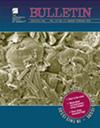High-temperature altered oceanic crust recycling into oceanic-island basalt−like mantle produces alkaline continental crust driven by mélange diapirs: Insights from isotopic tracing and numerical modeling
IF 3.7
1区 地球科学
Q1 GEOSCIENCES, MULTIDISCIPLINARY
引用次数: 0
Abstract
Genesis of the large-volume alkaline crust at active continental margin is still enigmatic for geologists worldwide. The point at issue is whether or not subducted oceanic crusts get involved and how they interact with the mantle source of the alkaline crust. Late Mesozoic juvenile alkaline crusts with high εNd(t)-εHf(t) values are widely distributed in the Great Xing’an Range of NE China, as parts of an arc magmatic belt related to the Mongol-Okhotsk Ocean closure. We carried out multi-isotope analyses and 2-D high-resolution numerical modeling to trace the mantle source nature of the alkaline crust. The alkaline rocks show similar trace elements with the I-type enriched mantle and are originated from an upwelling oceanic-island basalt−like mantle. Their high field strength element depleted arc features indicate the crustal material addition in the source region. Low δ18O, mantle-like Sr-Nd-Hf and light Mg isotope compositions, limited δ7Li variations, no Nd-Hf decoupling, and our mixing calculation preclude continental crustal assimilation, marine-sediment melt and/or altered oceanic crust (AOC)−fluid metasomatism, and bulk marine sediment involvement, and provide evidence of the bulk AOC addition in the mantle source. Lower δ18O values than the mantle and relatively low δ7Li values further confirmed the involved AOC to be a high-temperature (high-T) AOC. Our multi-isotope tracing successfully fingerprints the recycled high-T AOC into the source region of the alkaline juvenile crust. Then, our 2-D high-resolution numerical modeling reconstructs the high-T AOC recycling processes driven by mélange melting.高温蚀变的洋壳再循环到洋岛玄武岩样地幔中,产生由mélange底辟驱动的碱性大陆壳:同位素示踪和数值模拟的见解
对于世界各地的地质学家来说,活动大陆边缘大体积碱性地壳的成因仍然是个谜。争论的焦点是俯冲的洋壳是否参与其中,以及它们如何与碱性地壳的地幔源相互作用。εNd(t)-εHf(t)值较高的晚中生代新生碱性结壳广泛分布于中国东北大兴安岭,是与蒙古-鄂霍次克洋闭合有关的弧岩浆带的一部分。我们进行了多同位素分析和二维高分辨率数值模拟,以追踪碱性地壳的地幔源性质。碱性岩石显示出与I型富集地幔相似的微量元素,起源于上升流的洋岛玄武岩样地幔。它们的高场强元素贫化弧特征表明源区地壳物质增加。低δ18O、类地幔Sr-Nd-Hf和轻Mg同位素组成、有限的δ7Li变化、无Nd-Hf解耦,以及我们的混合计算排除了大陆地壳同化、海洋沉积物熔融和/或蚀变海洋地壳(AOC)-流体交代作用以及大量海洋沉积物的参与,并提供了地幔源中大量AOC添加的证据。δ18O值低于地幔,δ7Li值相对较低,进一步证实了所涉及的AOC是高温(高T)AOC。我们的多同位素追踪成功地将回收的高T AOC指纹到碱性新生地壳的源区。然后,我们的二维高分辨率数值建模重建了由金属熔化驱动的高T AOC回收过程。
本文章由计算机程序翻译,如有差异,请以英文原文为准。
求助全文
约1分钟内获得全文
求助全文
来源期刊

Geological Society of America Bulletin
地学-地球科学综合
CiteScore
9.30
自引率
8.20%
发文量
159
审稿时长
4-8 weeks
期刊介绍:
The GSA Bulletin is the Society''s premier scholarly journal, published continuously since 1890. Its first editor was William John (WJ) McGee, who was responsible for establishing much of its original style and format. Fully refereed, each bimonthly issue includes 16-20 papers focusing on the most definitive, timely, and classic-style research in all earth-science disciplines. The Bulletin welcomes most contributions that are data-rich, mature studies of broad interest (i.e., of interest to more than one sub-discipline of earth science) and of lasting, archival quality. These include (but are not limited to) studies related to tectonics, structural geology, geochemistry, geophysics, hydrogeology, marine geology, paleoclimatology, planetary geology, quaternary geology/geomorphology, sedimentary geology, stratigraphy, and volcanology. The journal is committed to further developing both the scope of its content and its international profile so that it publishes the most current earth science research that will be of wide interest to geoscientists.
 求助内容:
求助内容: 应助结果提醒方式:
应助结果提醒方式:


